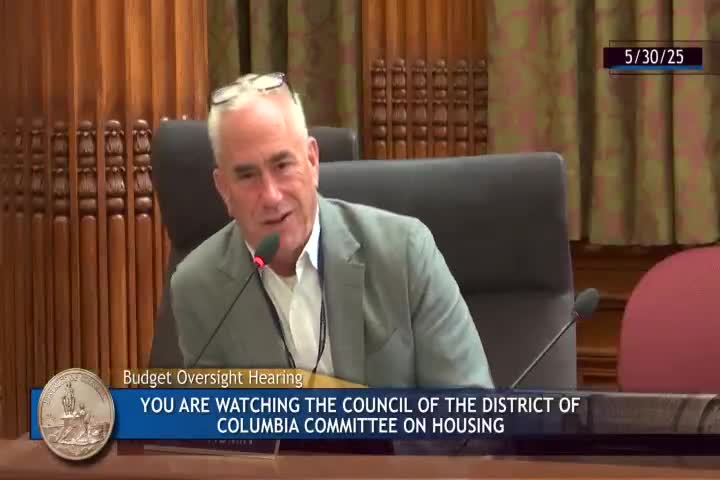DCHA outlines strategies to improve public housing unit occupancy and repairs
May 30, 2025 | Committee on Housing, Committees, Legislative, District of Columbia
This article was created by AI summarizing key points discussed. AI makes mistakes, so for full details and context, please refer to the video of the full meeting. Please report any errors so we can fix them. Report an error »

In a recent budget oversight hearing led by Chairperson Robert White, the Committee on Housing addressed pressing issues surrounding the District of Columbia's housing landscape. The meeting, held on May 30, 2025, highlighted significant concerns regarding the rent registry and occupancy rates, which are critical to the city's housing stability.
One of the key discussions revolved around the discrepancies in apartment sizes and their impact on rent evaluations. Councilmember Fruhman raised a concern about the fairness of comparing rents for vastly different units, such as a 1,000 square foot three-bedroom apartment versus a 500 square foot one. He emphasized that such comparisons could lead to inflated rents, ultimately disadvantaging those on waiting lists for housing vouchers. The committee acknowledged the challenge of incorporating square footage into rent assessments, noting that while the U.S. Department of Housing and Urban Development (HUD) does not mandate this, it remains a crucial factor in determining the value of apartments.
The conversation then shifted to occupancy rates within the District's housing authority. Officials discussed new systems being implemented to track units that are coming back online after being offline for repairs. The goal is to improve efficiency in leasing these units, ensuring they are ready for occupancy as soon as they are deemed habitable. The committee expressed optimism that these measures would enhance occupancy numbers, which have been a concern due to the lengthy turnaround times for repairs.
However, the meeting also revealed deeper issues related to tenant preferences. Many individuals are selective about where they wish to live, often rejecting available units in less desirable areas. This reluctance poses a challenge for housing authorities, which are now exploring creative solutions to make these properties more appealing. Suggestions included potential partnerships with local law enforcement to address safety concerns and community programming to enhance neighborhood livability.
As the meeting concluded, the committee recognized the complexity of the housing situation in the District. With ongoing discussions about improving the rent registry and addressing occupancy challenges, officials are committed to finding solutions that ensure fair and accessible housing for all residents. The outcomes of these discussions will be crucial as the city continues to navigate its housing crisis, striving to meet the needs of its diverse population.
One of the key discussions revolved around the discrepancies in apartment sizes and their impact on rent evaluations. Councilmember Fruhman raised a concern about the fairness of comparing rents for vastly different units, such as a 1,000 square foot three-bedroom apartment versus a 500 square foot one. He emphasized that such comparisons could lead to inflated rents, ultimately disadvantaging those on waiting lists for housing vouchers. The committee acknowledged the challenge of incorporating square footage into rent assessments, noting that while the U.S. Department of Housing and Urban Development (HUD) does not mandate this, it remains a crucial factor in determining the value of apartments.
The conversation then shifted to occupancy rates within the District's housing authority. Officials discussed new systems being implemented to track units that are coming back online after being offline for repairs. The goal is to improve efficiency in leasing these units, ensuring they are ready for occupancy as soon as they are deemed habitable. The committee expressed optimism that these measures would enhance occupancy numbers, which have been a concern due to the lengthy turnaround times for repairs.
However, the meeting also revealed deeper issues related to tenant preferences. Many individuals are selective about where they wish to live, often rejecting available units in less desirable areas. This reluctance poses a challenge for housing authorities, which are now exploring creative solutions to make these properties more appealing. Suggestions included potential partnerships with local law enforcement to address safety concerns and community programming to enhance neighborhood livability.
As the meeting concluded, the committee recognized the complexity of the housing situation in the District. With ongoing discussions about improving the rent registry and addressing occupancy challenges, officials are committed to finding solutions that ensure fair and accessible housing for all residents. The outcomes of these discussions will be crucial as the city continues to navigate its housing crisis, striving to meet the needs of its diverse population.
View full meeting
This article is based on a recent meeting—watch the full video and explore the complete transcript for deeper insights into the discussion.
View full meeting